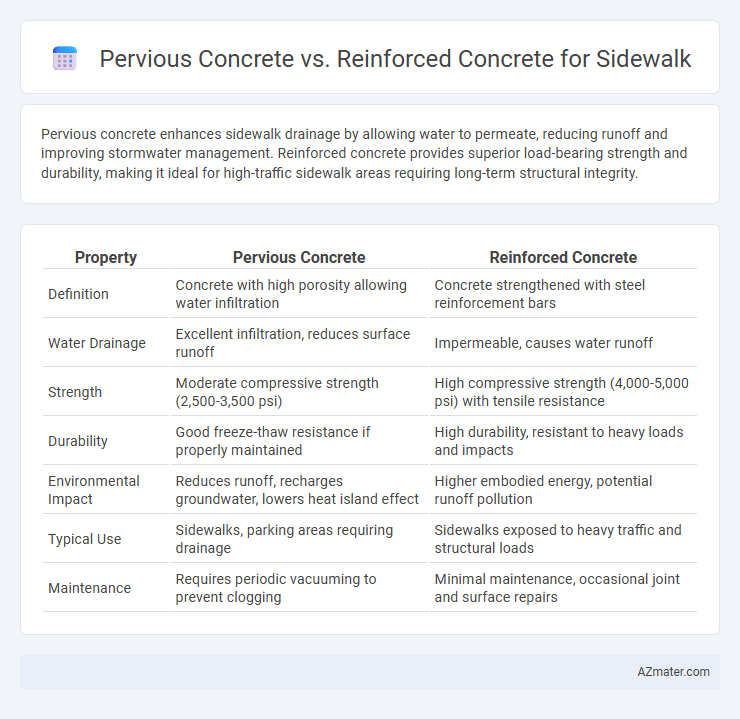Pervious concrete enhances sidewalk drainage by allowing water to permeate, reducing runoff and improving stormwater management. Reinforced concrete provides superior load-bearing strength and durability, making it ideal for high-traffic sidewalk areas requiring long-term structural integrity.
Table of Comparison
| Property | Pervious Concrete | Reinforced Concrete |
|---|---|---|
| Definition | Concrete with high porosity allowing water infiltration | Concrete strengthened with steel reinforcement bars |
| Water Drainage | Excellent infiltration, reduces surface runoff | Impermeable, causes water runoff |
| Strength | Moderate compressive strength (2,500-3,500 psi) | High compressive strength (4,000-5,000 psi) with tensile resistance |
| Durability | Good freeze-thaw resistance if properly maintained | High durability, resistant to heavy loads and impacts |
| Environmental Impact | Reduces runoff, recharges groundwater, lowers heat island effect | Higher embodied energy, potential runoff pollution |
| Typical Use | Sidewalks, parking areas requiring drainage | Sidewalks exposed to heavy traffic and structural loads |
| Maintenance | Requires periodic vacuuming to prevent clogging | Minimal maintenance, occasional joint and surface repairs |
Introduction to Pervious and Reinforced Concrete
Pervious concrete is a specially designed material with high porosity that allows water to pass through, making it ideal for sustainable sidewalk applications by reducing runoff and promoting groundwater recharge. Reinforced concrete incorporates steel bars or mesh to enhance tensile strength and durability, providing a strong, long-lasting surface capable of withstanding heavy pedestrian and vehicular traffic on sidewalks. Both materials serve distinct functional needs: pervious concrete supports environmental stormwater management, while reinforced concrete ensures structural integrity and safety in urban infrastructure.
Composition and Material Differences
Pervious concrete for sidewalks features a unique mix of coarse aggregates, little to no fine aggregates, and a lower cement content, allowing water to permeate through its porous structure. Reinforced concrete incorporates cement, fine and coarse aggregates, water, and steel reinforcement bars to enhance strength and durability, resulting in a dense, impermeable surface. The primary material difference lies in pervious concrete's open-graded aggregate structure aimed at water infiltration, while reinforced concrete focuses on structural load-bearing and crack resistance through integrated steel reinforcement.
Permeability and Drainage Capabilities
Pervious concrete offers superior permeability and drainage capabilities compared to reinforced concrete, allowing water to pass through its porous structure and reducing surface runoff. Reinforced concrete, while structurally stronger due to embedded steel, is impermeable and often requires additional drainage systems to manage water accumulation. The permeability of pervious concrete significantly enhances stormwater management and mitigates flooding risks on sidewalks.
Strength and Load-Bearing Capacity
Pervious concrete offers moderate compressive strength typically ranging from 2,500 to 4,500 psi, suitable for light pedestrian loads on sidewalks, while reinforced concrete provides significantly higher strength, often exceeding 4,000 psi with steel reinforcement enhancing tensile and flexural capacity for heavier pedestrian and occasional vehicular loads. Reinforced concrete's load-bearing capacity is superior due to embedded steel bars that distribute stresses and resist cracking, making it ideal for sidewalks exposed to dynamic or heavy loading conditions. Pervious concrete prioritizes permeability and drainage over maximum strength, making it less suitable for high load-bearing applications compared to reinforced concrete.
Durability and Lifespan
Pervious concrete offers enhanced water permeability, reducing surface runoff and minimizing freeze-thaw damage, which contributes to improved durability in sidewalk applications. Reinforced concrete provides superior structural strength due to embedded steel bars, resulting in a longer lifespan under heavy loads and resistance to cracking. While pervious concrete typically has a shorter lifespan of 10 to 20 years, reinforced concrete sidewalks often exceed 30 years with proper maintenance and protection from environmental factors.
Environmental Impact and Sustainability
Pervious concrete significantly reduces stormwater runoff by allowing water infiltration, improving groundwater recharge, and decreasing the risk of urban flooding, making it an eco-friendly choice for sidewalks. Reinforced concrete, while structurally stronger, often requires more energy-intensive materials and produces higher carbon emissions during production, contributing to environmental degradation. Choosing pervious concrete enhances sustainability by promoting natural water cycles and reducing the heat island effect commonly associated with traditional concrete surfaces.
Maintenance Requirements and Repair
Pervious concrete sidewalks require more frequent maintenance to prevent clogging of pores, typically involving regular vacuuming or pressure washing to maintain permeability. Reinforced concrete sidewalks generally have lower maintenance demands but may necessitate more significant repairs like crack filling or slab replacement due to surface wear or structural damage. Repair processes for pervious concrete emphasize restoring permeability, whereas reinforced concrete repairs focus on structural integrity and durability.
Cost Comparison: Installation and Lifecycle
Pervious concrete for sidewalks typically involves higher initial installation costs due to specialized materials and infiltration system requirements compared to reinforced concrete, which uses conventional mixes and established methods. Over the lifecycle, pervious concrete reduces costs related to stormwater management, such as drainage infrastructure and maintenance, offering significant savings in urban settings. Reinforced concrete may incur lower upfront expenses but often demands more frequent repairs and stormwater management investments, leading to higher long-term costs.
Best Use Cases for Sidewalk Applications
Pervious concrete is ideal for sidewalks in areas requiring efficient stormwater management, as its high permeability reduces runoff and promotes groundwater recharge. Reinforced concrete provides superior structural strength and durability, making it suitable for sidewalks subjected to heavy pedestrian traffic or occasional vehicular loads. Selecting between pervious and reinforced concrete depends on site-specific factors such as drainage needs and load-bearing requirements for optimal sidewalk performance.
Conclusion: Choosing the Right Concrete for Sidewalks
Pervious concrete offers enhanced stormwater management by allowing water infiltration, reducing runoff and promoting groundwater recharge, making it ideal for environmentally sensitive sidewalks. Reinforced concrete provides superior strength and durability, ensuring long-term load-bearing capacity and resistance to cracking under heavy pedestrian traffic or potential impacts. Selecting the right concrete depends on balancing environmental benefits with structural performance, where pervious concrete suits sustainable design goals and reinforced concrete excels in high-load or high-traffic sidewalk applications.

Infographic: Pervious concrete vs Reinforced concrete for Sidewalk
 azmater.com
azmater.com